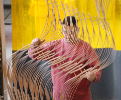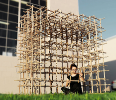Cages

Curving Involute by Evan Glickman and Cody Willson
The work in Cages explores the qualities of material boundaries and enclosing conditions that relate structure and skin, establishing critical connections between the natural and the artificial in the material experience.
Galleries
Curving Involute - Evan Glickman and Cody Willson
‘Chidori’ - Eric Chambers, Blake Kane, and Swapnil Patil
Reflexive Fabric -Lemma Al-Ghanem and Elias Kotzambasis
Students
Lemma Al-Ghanem/Elias Kotzambasis,
Eric Chambers/Blake Kane/Swapnil Patil,
Evan Glickman/Cody Wilson
Faculty
Term
ARC 606, Spring 2018
Program
MArch – Material Culture
Through the production of wooden structures with considerations of matter, fabrication, form and emotion, the research and structures explored operations of transverse physical and visual relationships.
Working with wood allowed the design teams to approach aspects of assemblage, joinery, or lightness, but also permitted work with potential expressions in terms of mass, continuity, and weight. The material exploration of wood took place at three different scales, dealing with structure, facture and texture: for the structure, teams worked on the arrangement of and relations between different elements of the supporting system; for the facture, teams worked on the definition of the joints that brought all elements together; and for the texture, teams worked on the definition of the appearance and the feel of the final surface finish.
What inspires me are the interactions between human and structure, site and nature, the tactile and sensual...
- Evan Glickman, MArch
The design incorporated the notion of a space for the inspiration, introversion, reflection, and isolation of the body and mind. This consideration gave additional information on how to explore a material from a programmatic perspective, providing an intuition on aspects like the occupation, the scale, the access, the manipulation, or the openness of the final piece.
Designing and building in groups, the students behind the constructions considered the unique inspiration of wood, and its many properties. Wood offered a connection to the tectonic qualities of the North American building tradition and a national architectural identity. It is also a universal resource and a sustainable material that implies a critical connection with nature, linking the natural and the artificial.
Wood is at once traditional and contemporary. Few materials can be considered more intimately connected to and respectful of the environment, connecting past and future in the way wood does.





























